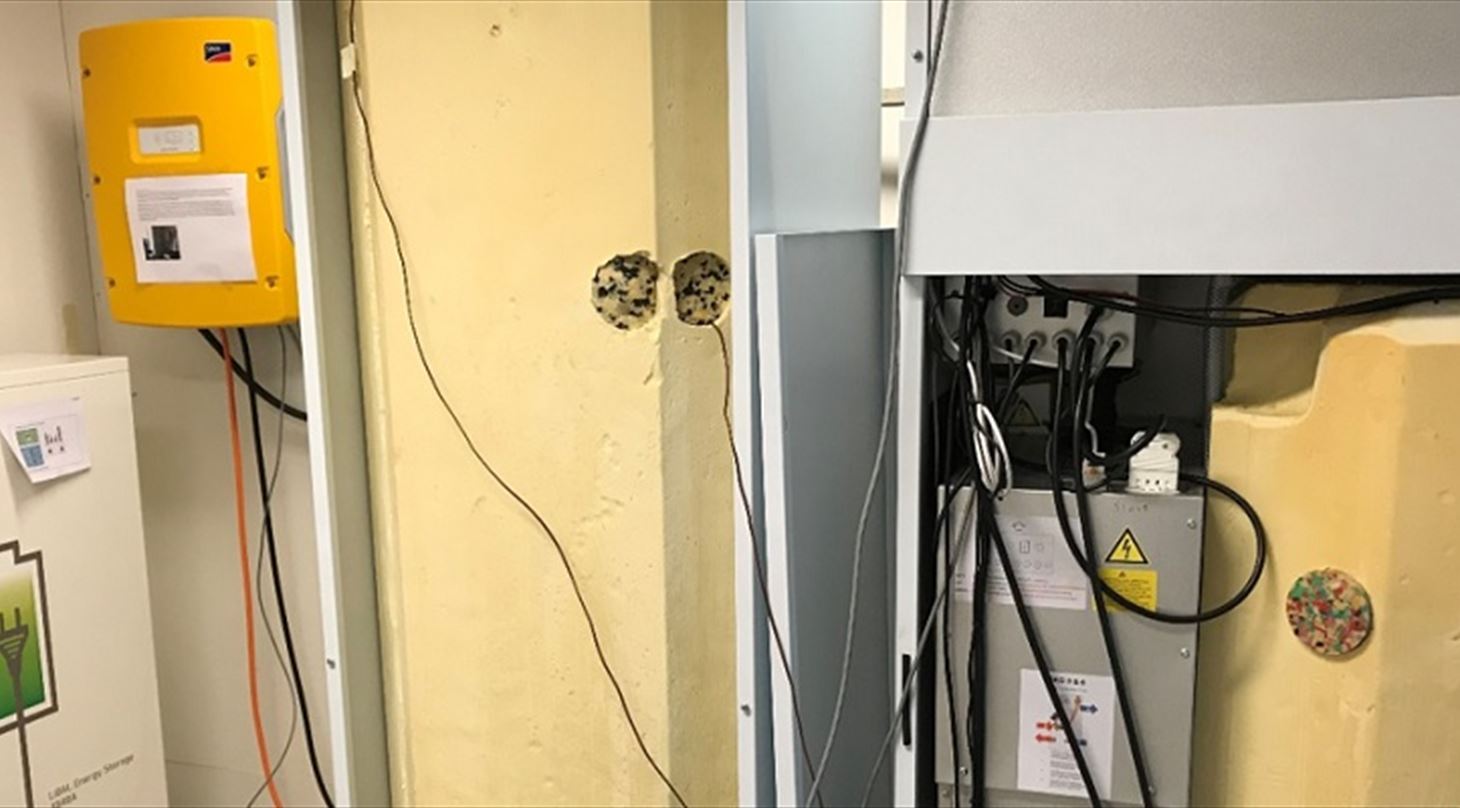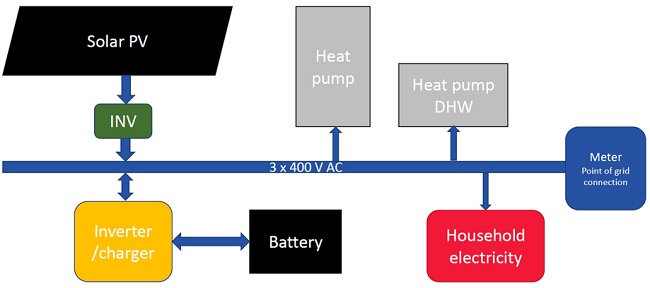
Udnyttelse af solcelle-el i énfamiliehus med batteri og varmepumpe - et Elforsk-projekt - English summary
Vælg side
Self-consumption of PV electricity in single-family house with battery and heat pump
At Danish Technological Institute (DTI) a combined energy plant consisting of solar cells (PV), battery storage, heat pumps for domestic water and for heating the house through floor heating has been built and tested. The project is supported by ELFORSK, and the participants are - besides Danish Technological Institute - Lithium Balance, which has supplied batteries, and Nilan A / S, which has supplied the heat pump
A high rate of self-consumption of electricity is key for PV owners in many countries, and this has kick-started a new market for energy storage in households, most frequently batteries. Even though batteries are becoming cheaper, they cannot beat simple thermal storage in water tanks or in concrete floors of buildings. The heating installations and constructions are there anyway, so why not use them as almost free storage capacity.
Project objectives
It is the overall objective to design a versatile combined energy system for houses with combined PV (solar cells), battery-system, heat pump installations and thermal storage.
The purpose is thus to investigate how the operation of such a combined energy system must be designed to achieve the best efficiency and at the same time ensure that as much electricity as possible is used in the house. The main idea is that the overall efficiency can be increased by adapting the power electronics and the heat pump control. By linking heat pump and battery as electrical storage for solar cells, and controlling energy flows, the most inefficient operating conditions of both storage modes should be avoided. In practice, this means charging and discharging with a certain minimum power to minimize the losses.
Another important purpose was to prepare a user-friendly design and calculation tool for use by planners, installers and homeowners with some technical insight. The tool is able to calculate the annual energy balance and economic value of electrical and thermal energy storage in connection with solar power plants. The program can be used for preliminary sizing of solar PV systems, batteries and heat pump with associated storage.
Finally, heat pump manufacturer Nilan has developed a new (SG (smart grid) ready) control system and buffer tank, which was tested in the project and Lithium Balance has tested a new battery management system.
The project
DTI has installed and monitored a system consisting of PV plant, heat pump and battery with SMA Sunny Island inverter in a house with floor heating. The project shows how such an installation can be realized in practice, using available standard components and control software. There have been many hurdles – some of them have been solved – and all of them have given practical experience when going from desktop planning to a functioning and user-friendly installation.
How it works
The solar electricity primarily covers ordinary household electricity and electricity for heat pumps, then the battery is charged and finally power is exported to the grid when heat pump storage and the batteries are fully charged. The battery discharges in order to cover all needs in the house - typically in the peak-hours in the afternoon. Only when the battery is discharged, or the power exceeds the capacity of the battery inverter, power is purchased from the grid.
The heat pump has a buffer tank, so that the installation can contain more energy than usual, and the house has a relatively heavy concrete floor, which is also used as a buffer by increasing the temperature of the floor heating system when excess PV power is available. The control of the components' interaction and operating mode is realized via the inverter manufacturer's internet-based portal.
Through the seasons with large variations in the outdoor climate, data on energy flows has been collected periodically over the course of a year, and knowledge is gained about how much self-consumption of solar PV electricity can be increased by means of battery and heat pumps, and which storage efficiency can be achieved. In this context, there was a thorough work with, among other things, controlling the battery, and in particular getting the control from the battery inverter to the heat pump to function as smartly as possible.

In the best operating periods, 77% total efficiency has been measured for the battery system. The losses are partly due to the own consumption of the battery's own consumption for the BMS system, the loss of the cells, ohmic losses and loss in the inverter.
The heat pump is “Smart Grid Ready” and is controlled by Wi-Fi signals from a cloud-based monitoring and control platform.
Regarding thermal energy storage in the floor, it was a problem that the heating system was built up with two mixing circuits (shunt valves), and that the room thermostats set a limit when water circulates in the floor heating. This makes economical operation of the heat pump and the potential energy storage difficult. After deactivation of shunt circuits and full opening of thermostats, the system worked well but with some fluctuation of the room temperature. There is therefore a need for a more intelligent coupling between the room temperature control and the heat pump's control system (incl. Smart grid).
Results achieved
The main results of the project can be summarized as follows:
- We have built a functioning advanced energy system which combines solar PV, battery, heat pump and heat storage in a home.
- We have demonstrated state-of-the art within IoT (control through the Internet) for the home's energy management.
- In order to optimize the utilization of solar electricity production, we have conducted experiments to raise the temperature of both heat pump vessels during periods of the day so that it could absorb more solar energy. Also, attempts have been made to show in which periods the heat pump could be switched off.
- The storage potential of the heat pump by raising the temperature 10 degrees C is approx. 5 kWh, and with the included efficiency from the heat pump this corresponds to approx. 2 kWh of electricity. In addition, there is a storage potential in the concrete floor of approx. 45 kWh - equivalent to 15 - 20 kWh of solar cell electricity.
- Total efficiency of charging and discharging the battery system varies from 66% to 77% month by month depending on load. Charging and discharging at low power results in high losses. The efficiency can therefore be increased by raising the power limit for charging / discharging (and ensuring that inverter idling is avoided).
- The same amount of energy (primary electricity) can be stored in the tested battery as in the heat storage system of the heat pump system.
- Storage in an electrically heated water heater is still (one of the) most economical storage options, as there is also a need for hot water in the summer.
- Storage in thermal storage using floor heating works well during the heating season, but it is required that the mixing circuits are switched off and the room thermostats are opened completely. Therefore, there is a need for more intelligent coupling between the housing temperature control and the heat pump control system. In a newly started EUDP project (OPSYS2) this challenge will be addressed.
- In the project, a user-friendly spreadsheet has been prepared for calculating energy flows and the economic saving of the various storage measures. Through the use of the calculator with current consumption and prices for electricity, solar cells, batteries and heat pumps, the project can be assessed – concerning as well energy as economy.
- The largest savings are obtained from the PV plant itself, by displacing grid electricity. There is a further saving by investing in battery and / or heat storage up to a certain limit, which can typically double the self-consumption of PV power.
- If you already have a heat pump with thermal buffer, this is a good storage option as it is only a matter of changing the control to make its electricity consumption flexible.
- A simple design tool for combined battery storage and thermal storage has been developed.
The main practical experience is:
- It is not easy for an advisor / installer to design a system with PV, batteries and / or heat pumps, as it is often difficult to get different components to communicate.
Therefore:
- It is not easy for an advisor / installer to design a system with PV, batteries and / or heat pumps, as it is often difficult to make different components communicate.
- Select components from the same company - or components that can communicate for sure. The system should be integrated, tested and installed by the same installer.
- Select components from companies with technical customer support.
- Choose a battery inverter that is relatively small compared to the PV system. Alternatively, the relatively small base load must be purchased from the electrical grid.
The project shows that the consumption pattern is of paramount importance when planning a control and storage system, and that energy losses are substantial if care is not taken in the design phase. Other important results are that ordinary concrete floor heating systems can store a large amount of energy without major fluctuation in room temperature.
The project shows opportunities – such as using the battery-storage for external energy – (e.g. wind power or hydro) – and barriers such as efficiency and noise, difficulties for users.
Also, the economic perspective is considered – mainly in the spreadsheet (calculation programme) for evaluation of energy storage in connection with solar PV systems. As a consumer or RE-installer / dealer, it is of great value to be able to test different scenarios before deciding on a specific plant size and structure. For example, a light building and a heavy building will have different options for integrating thermal energy storage.